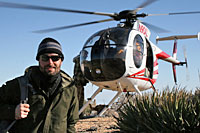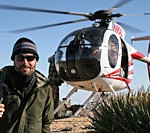

 During the second week of March, I participated in a helicopter survey of golden eagles and their nests along the rugged, remote, and spectacular ridges and canyons of the Sierra de Juárez Mountains in Baja California, Mexico. The survey was conducted under the auspices of Sempra Energy, which is obligated by the state government to provide a percentage of their power production through clean and renewable sources.
During the second week of March, I participated in a helicopter survey of golden eagles and their nests along the rugged, remote, and spectacular ridges and canyons of the Sierra de Juárez Mountains in Baja California, Mexico. The survey was conducted under the auspices of Sempra Energy, which is obligated by the state government to provide a percentage of their power production through clean and renewable sources.
Sempra has obtained a lease from an ejido (cooperative farming) community to install an extensive wind farm across the northern Baja peninsula. Wind farms have great potential to reduce much of our dependency on fossil fuels by generating large amounts of electrical energy from a renewable resource with no direct byproduct pollutants. However, wind farms can also pose a considerable hazard to bird and bat populations. Wind turbines that are improperly located without regard to wildlife habitat use and movement patterns can cause high levels of injury and mortality to flying animals.
Sempra has contracted San Diego Zoo Conservation Research to conduct a full-scale survey and analysis of golden eagle population characteristics, habitat use, and movement behaviors throughout the planned wind farm site. The eagle study is part of a comprehensive assessment to avoid and mitigate the environmental impacts of the turbines. The golden eagle has high ecological and conservation management importance as a keystone species and is of particular cultural significance to Mexico as a national icon. Sempra views proper safeguarding of the golden eagle populations in the wind farm area as an essential aspect of good environmental stewardship and vital to maintaining favorable binational relations with Mexican stakeholders.
Golden eagles can range hundreds of miles while foraging for their food resources, such as rodents and rabbits. Eagles often use mountain ridges to ride the thermal updrafts that sweep up from the valleys and deserts below so as to gain elevation without expending much flying effort. Unfortunately, their propensity to seek out strong winds can bring the birds into proximity with wind farms. Locating golden eagles that maintain large home ranges can be very challenging. Fortunately, golden eagles can be found during the mating season in late winter/early spring as they maintain territories and incubate eggs in clifftop eyries. The remoteness and ruggedness of their habitats often precludes field-based observations of eagles from being conducted by foot or motor vehicle, so many surveys are instead done via helicopter.An experienced team of ecologists and wildlife researchers from San Diego Zoo Conservation Research led the search for golden eagles along the mountain ridges of the proposed Sempra wind farm site in northern Baja. Team leader Dr. Lisa Nordstrom organized the survey with the assistance of Dr. Mike Wallace, Dianne Van Dien, and yours truly. Staff from the Wildlife Research Institute provided integral planning and field support, particularly executive director Dave Bittner, who has decades of experience studying raptors in the wild.
The survey ran for three days and consisted of broad sweeps of golden eagle habitat from a chartered helicopter. Groups of three researchers took turns taking helicopter-based observations in two-hour blocks, scanning the Baja peaks, canyons, mesas, and buttes for signs of eagles and their nests. To facilitate easier viewing, the helicopter doors were detached, which made for an extremely bracing ride as the frigid winter mountain air roared into the cockpit! After soaring across the frosted boughs of the conifer and pines of the Baja ranch that served as our field base, our pilot would fly us over the edge of the mountain escarpment. Suddenly, the earth would drop away and the aircraft would be suspended 5,000 feet over the majestic canyon system of the Sierra de Juárez Mountains. Our expert pilot hovered his craft less than 30 feet from the rock face as we buzzed up and down the sheer canyon walls at high speed, searching for eagles and their nests.The northern section of the survey covered habitat that was mostly barren, jagged rock, but we were able to locate four nests and spot several golden eagles in the less-desolate central and southern sections. We also observed red-tailed hawks and turkey vultures, as well as three distinct herds of bighorn sheep that were grazing among the giant barrel cacti on the steep slopes.
 The GPS coordinates of the nests were recorded so that researchers can travel into the area to catch wild eagles for the next phase of the project. At least six free-ranging golden eagles will be fitted with miniaturized GPS transmitters so that their movement patterns can be monitored remotely over the next two years. The data from the eagles will be analyzed to characterize their movement patterns and habitat use across seasons. Data on the movements of the California condors that are being reintroduced to the Baja peninsular by the San Diego Zoo will also be included.
The GPS coordinates of the nests were recorded so that researchers can travel into the area to catch wild eagles for the next phase of the project. At least six free-ranging golden eagles will be fitted with miniaturized GPS transmitters so that their movement patterns can be monitored remotely over the next two years. The data from the eagles will be analyzed to characterize their movement patterns and habitat use across seasons. Data on the movements of the California condors that are being reintroduced to the Baja peninsular by the San Diego Zoo will also be included.
This information will be used to inform planning strategies for the optimal location and operation of the wind farm and provide a predictive management tool so that the risk of harm to the birds and their habitats is minimized.
James Sheppard is a Postdoctoral Fellow for San Diego Zoo Conservation Research.
Here’s more information about James’ project
Read James’ previous blog, Are Condors Blown By the Wind?


















